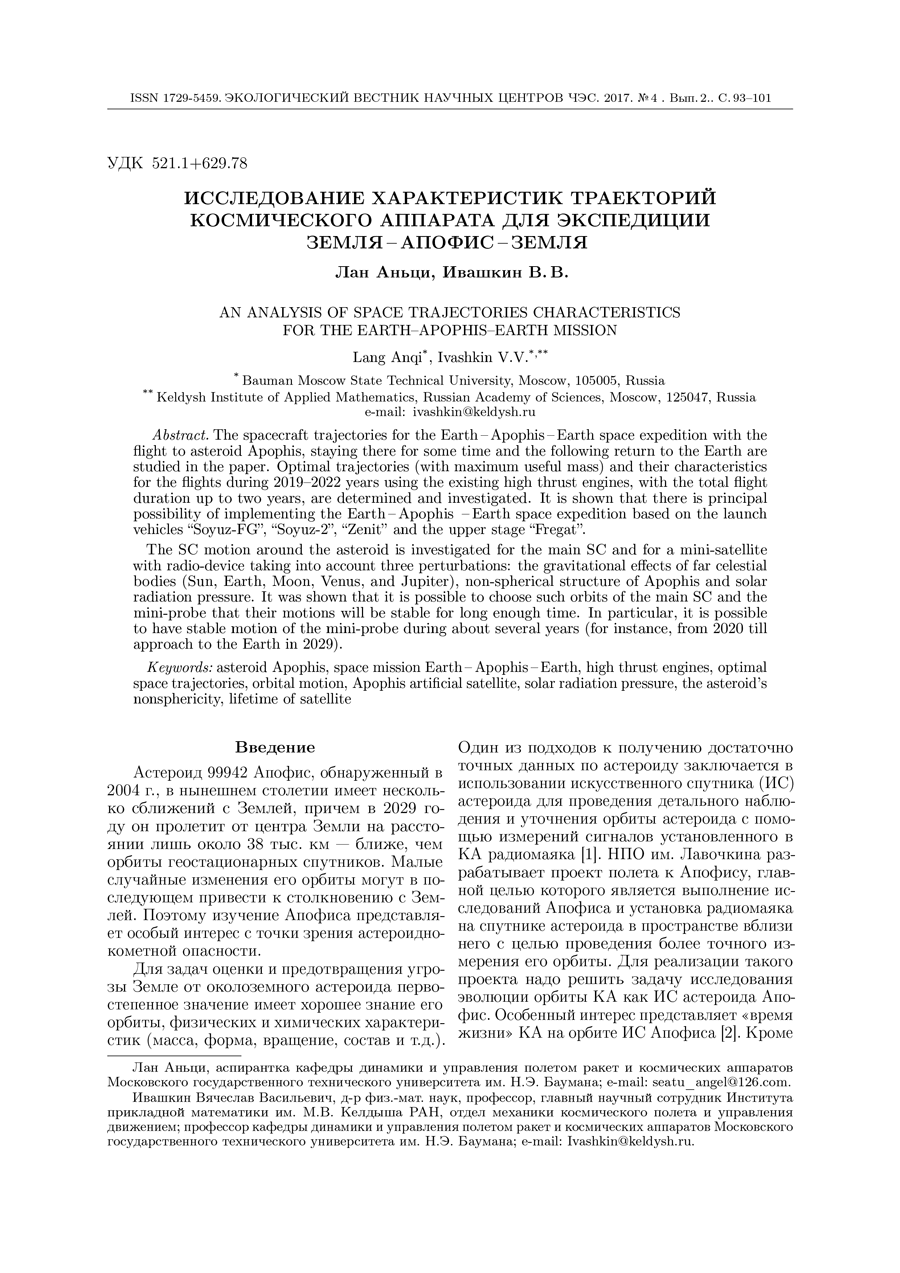An analysis of space trajectories characteristics for the Earth-Apophis-Earth mission
UDC
521.1+629.78Abstract
The spacecraft trajectories for the Earth-Apophis-Earth space expedition with the flight to asteroid Apophis, staying there for some time and the following return to the Earth are studied in the paper. Optimal trajectories (with maximum useful mass) and their characteristics for the flights during 2019-2022 years using the existing high thrust engines, with the total flight duration up to two years, are determined and investigated. It is shown that there is principal possibility of implementing the Earth-Apophis -Earth space expedition based on the launch vehicles "Soyuz-FG", "Soyuz-2", "Zenit" and the upper stage "Fregat". The SC motion around the asteroid is investigated for the main SC and for a mini-satellite with radio-device taking into account three perturbations: the gravitational effects of far celestial bodies (Sun, Earth, Moon, Venus, and Jupiter), non-spherical structure of Apophis and solar radiation pressure. It was shown that it is possible to choose such orbits of the main SC and the mini-probe that their motions will be stable for long enough time. In particular, it is possible to have stable motion of the mini-probe during about several years (for instance, from 2020 till approach to the Earth in 2029).
Keywords:
asteroid Apophis, space mission Earth-Apophis-Earth, high thrust engines, optimal space trajectories, orbital motion, Apophis artificial satellite, solar radiation pressure, asteroid's nonsphericity, lifetime of satelliteReferences
- Shustov B. M., Ryhlova L.M. (eds.) Asteroidno-kometnaja opasnost': vchera, segodnja, zavtra. [Asteroid-comet danger: yesterday, today, tomorrow]. Moscow, FIZMATLIT, 2010, 384 p. (In Russian)
- V.G. Pol', A.V. Simonov, K.G. Suhanov. O stabil'nost' orbity sputnik malogo nebesnogo tela, vozmuschaemogo vneshnim telom. [On stability of satellite orbit of a small celestial body, perturbed by the external body]. Vestnik NPO im. S.A. Lavachkina [Bull. of SPU named S.A. Lavochkin]. 2010, no. 2, pp. 17-23. (In Russian)
- Sandford S A. The Power of Sample Return Missions-Stardust and Hayabusa [J]. In: Proc. of the International Astronomical Union, 2011, vol. 7(S280), pp. 275-287.
- Ajluni T, Everett D, Linn T, et al. OSIRIS-REx, returning the asteroid sample [C]. In: Proc. of Aerospace Conference, 2015 IEEE, 2015, pp. 1-15.
- Il'in V.A., Kuzmak G.E. Optimal'nye perelety kosmicheskih apparatov s dvigateljami bol'shoj tjagi [Optimum flights of spacecrafts with high-thrust engines]. Moscow, Nauka Pub., 1976, 744 p. (In Russian)
- Sobol' I.M., Statinkov R.B. Vybor optimal'nyh parametrov v zadachah so mnogimi kriterijami. Moscow, Nauka, 1981, 110 p. (In Russian)
- Glandorf D.R. Lagrange Multipliers and the State Transition Matrix for Coasting Arcs. AIAA Journal, 1968, vol. 7, no. 2, pp. 363-365.
- Lion P.M., Handelsman M. The Primer Vector on Fixed-Time Impulsive Trajectories. AIAA Journal, 1968, vol. 6, no. 1, pp. 127-132.
- Lang Anqi. Analiz kosmicheskih traektorij dlja ehkcpedicii Zemlja-Apofis-Zemlja i dvizhenija kocmicheskogo apparata vokruk asteroid Apofis [The analysis of the space trajectories for the Earth-Apophis-Earth expedition and the motion of the spacecraft around the asteroid Apophis]. Inzhenirnyj zhurnal: nauka I innovacii [Engineers J.: science and innovations], 2017, iss. 7. (In Russian)
- Pravec P., Scheirich P., Durech J. et al. The tumbling spin state of (99942) Apophis. Icarus, 2014, vol. 233, pp. 48-60.
- Ivashkin V.V., Lang A. Analysis of spacecraft orbital motion around the asteroid Apophis. Doklady Physics, 2016, vol. 61, no. 6, pp. 288-292.
- Anqi Lang, Ivashkin V.V. Dynamics of Spacecraft Orbital Motion around Asteroid Apophis. In: Proc. of the International Astronautical Congress, IAC. 2016. Paper IAC-16-C1,6,2, x33922, 12 p.
- Ivashkin V.V. and Lang, A. Analysis of the Orbital Motion of the Asteroid Apophis Satellite. Cosmic Research, 2017, vol. 55, no. 4, pp. 253-262.
- Duboshin G.N. Nebesnaya mekhanika. Osnovnye zadachi i metody [Celestial mechanics. Main tasks and methods], Moscow, Nauka, 1975, 799 p. (In Russian)
Downloads
Issue
Pages
Submitted
Published
How to Cite
Copyright (c) 2017 Lang A., Ivashkin V.V.

This work is licensed under a Creative Commons Attribution 4.0 International License.




